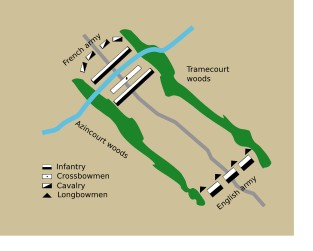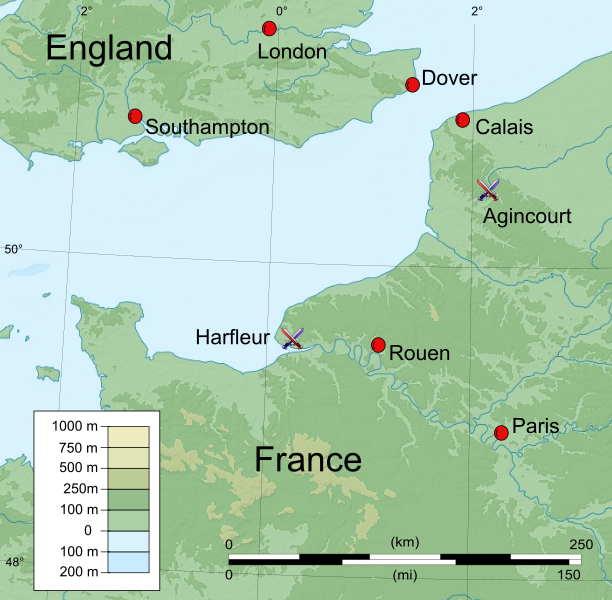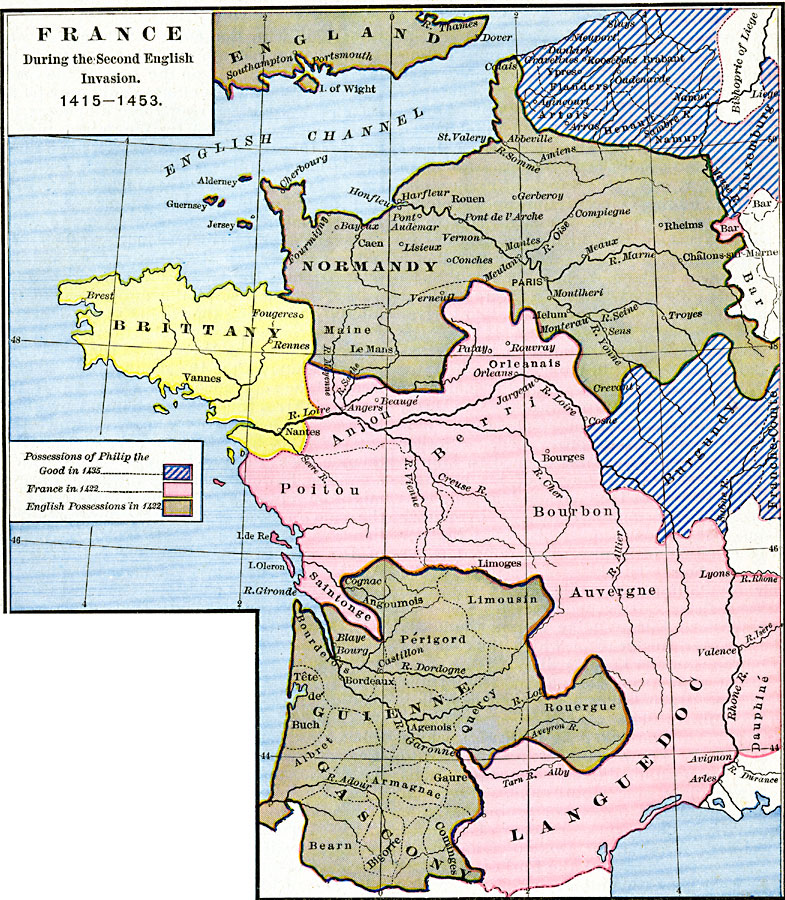OCR Specification focus:
‘the campaign of 1415 and Agincourt; command of the seas and relief of Harfleur; the campaign of 1417–1420 and the Treaty of Troyes (1420); the 1421 campaign’
Henry V’s campaigns (1415–1421) were central to his vision of restoring English prestige and power in France, combining military brilliance, naval strength, and diplomatic success.
Background to the Campaigns
Henry V inherited a fragile crown in 1413, but he quickly turned to France, seeking to strengthen his legitimacy through conquest. The Hundred Years’ War, resumed after intermittent truces, provided both an opportunity and a justification for asserting claims to French territories. By reviving English ambitions in Normandy, Henry linked military campaigns with dynastic ambition, using war to consolidate authority at home and abroad.
The Campaign of 1415
The campaign of 1415 stands out as Henry’s first major continental undertaking, culminating in the celebrated Battle of Agincourt. His objectives included securing Normandy, reviving English prestige, and demonstrating divine favour for his kingship.
The Siege of Harfleur
In August 1415, Henry launched his expedition and besieged Harfleur, a vital port in Normandy.
After several weeks of resistance, Harfleur surrendered in September.
However, the siege was costly, with heavy losses from dysentery and disease, weakening Henry’s forces before their march inland.
March to Calais
Henry’s army, reduced in number and weakened, attempted to march to the English stronghold of Calais. The French sought to intercept and destroy this vulnerable force before it could reach safety.
The Battle of Agincourt (25 October 1415)
The battle became legendary due to Henry’s remarkable victory against overwhelming odds.

A labelled battlefield diagram showing English positions faced by larger French forces compressed between flanking woodland. Arrows indicate the French advance into muddy ground and the killing zones of English longbowmen. Use this to explain why terrain and frontage shaped the outcome at Agincourt. Source
French numerical superiority: French forces heavily outnumbered the English.
English tactics: Henry positioned his men on a narrow field, flanked by woods, forcing the French into a compressed advance.
Longbowmen: Thousands of English archers devastated the French cavalry and infantry, especially in the muddy terrain.
Outcome: French nobility suffered catastrophic losses, while English casualties remained relatively light.
Longbow: A powerful type of bow, about six feet in length, used by English armies. Capable of rapid fire and long-range penetration, it was decisive at Agincourt.
The victory at Agincourt elevated Henry’s reputation across Europe, reinforcing his legitimacy and deterring domestic opposition. It also inspired English nationalism and strengthened the image of the king as chosen by God.
Command of the Seas
Control of the Channel was essential for sustaining English campaigns in France.

A labelled regional map of the Channel coast highlighting places in Henry V’s 1415–1416 campaign, including Harfleur and other ports used for supply and movement. It contextualises why secure sea lanes underpinned the siege and subsequent march. This image includes some locations beyond the syllabus focus but aids orientation. Source
Henry prioritised naval security, recognising that supply lines and reinforcements were vulnerable.
English fleets disrupted French shipping and defeated Franco-Genoese naval forces.
Harbours and ports captured in Normandy allowed Henry to establish secure bases.
Naval supremacy ensured the steady transport of troops and supplies, preventing French counter-offensives from cutting off English forces.
This maritime dominance was not merely defensive; it projected English power and underpinned Henry’s long-term campaign strategy.
The Campaign of 1417–1420
After consolidating his position in England, Henry resumed war in France on a much larger scale in 1417. This campaign marked a turning point, shifting English objectives from raids to systematic conquest.
Normandy Conquest
Henry captured towns and fortresses across Normandy, employing both military force and negotiated surrenders.
The fall of Caen (1417) and Rouen (1419) symbolised the collapse of French royal authority in Normandy.
By 1419, most of Normandy was under English control, strengthening Henry’s bargaining position.
Alliance with Burgundy
Henry exploited divisions in France, particularly the civil war between the Armagnacs and Burgundians.
The assassination of John the Fearless, Duke of Burgundy (1419), led his successor Philip the Good to ally with Henry.
This alliance isolated the Armagnac faction and opened the path to a diplomatic settlement.
The Treaty of Troyes (1420)
The Treaty of Troyes was the political pinnacle of Henry’s career.
Henry was recognised as heir and regent of France, marrying Catherine of Valois, daughter of Charles VI of France.
The agreement disinherited the Dauphin Charles (future Charles VII), transferring succession to Henry and his heirs.
France was effectively divided, with Henry exercising authority over large territories.
Treaty of Troyes (1420): A diplomatic settlement recognising Henry V as regent and heir to the French throne, formalising his marriage to Catherine of Valois.
This treaty transformed Henry from a conqueror into a legitimate ruler-in-waiting of both England and France.

A colour-coded historical map showing English-held Normandy and Guienne–Gascony c. 1422, alongside French and Burgundian areas, situating the Treaty of Troyes in territorial terms. It is ideal for explaining how recognition as regent and heir translated into control on the ground. The page also mentions later contexts (e.g., 1435 Arras), which exceed the syllabus and can be ignored. Source
The 1421 Campaign
Following the treaty, Henry sought to consolidate Anglo-French control by further campaigning. However, events began to expose the fragility of English success.
In 1421, English forces suffered a setback at the Battle of Baugé, where the Duke of Clarence, Henry’s brother, was killed.
The defeat revealed the limits of English power and the resilience of French resistance, especially from forces loyal to the Dauphin.
Though less celebrated, the 1421 campaign foreshadowed difficulties that Henry’s successors would face in maintaining the Anglo-French dual monarchy.
Overall Significance
Henry V’s campaigns between 1415 and 1421 transformed the course of the Hundred Years’ War. Through military victories, naval supremacy, and the Treaty of Troyes, he reached the height of English fortunes in France. Yet beneath the triumphs, logistical strains and continued French opposition hinted at challenges to come
FAQ
Henry V relied on a combination of parliamentary grants, loans from wealthy merchants, and revenue from crown lands. Parliament, persuaded by Henry’s leadership, granted taxes to fund the expedition.
He also revived traditional feudal obligations, requiring some nobles to serve with men-at-arms and archers. This mixed approach provided both manpower and financial resources, though it placed heavy burdens on English taxpayers.
Disease was a critical factor. Dysentery spread rapidly among Henry’s troops during the prolonged siege.
Thousands of soldiers were weakened or died.
Henry was forced to garrison Harfleur, leaving him with a reduced army for the march to Calais.
This significantly shaped the decision to avoid further sieges and contributed to the perilous march that culminated at Agincourt.
The battle exposed the fragility of English success after the Treaty of Troyes. The death of Thomas, Duke of Clarence, not only weakened English leadership but also emboldened Dauphinist forces.
It showed that English control in France was not guaranteed by treaty or earlier victories, and that continued resistance remained a serious challenge. The defeat foreshadowed the difficulties England would face after Henry’s death.
The marriage provided symbolic and dynastic legitimacy to Henry’s claim over France. By marrying the daughter of Charles VI, Henry connected his heirs directly to the French royal line.
This alliance strengthened the Treaty of Troyes, presenting the prospect of a united English and French monarchy under his descendants. However, it also created future tensions, as Catherine’s later marriage to Owen Tudor produced the Tudor line, reshaping English politics.
Henry had to maintain supply lines from England across the Channel while conducting sieges and campaigns in hostile territory.
Ensuring food and equipment reached troops was difficult.
Extended sieges, such as at Rouen, placed strain on both soldiers and resources.
Naval protection was essential to keep communications open.
Despite these challenges, Henry’s meticulous planning and use of secure ports like Harfleur allowed him to maintain the offensive and consolidate English control.
Practice Questions
Question 1 (2 marks)
In which year did Henry V win the Battle of Agincourt?
Mark Scheme:
1415 (2 marks)
Any incorrect date (0 marks)
Question 2 (6 marks)
Explain two reasons why the Treaty of Troyes (1420) was significant for Henry V’s position in France.
Mark Scheme:
Up to 3 marks per reason.
1 mark for simple identification, 2–3 marks for developed explanation.
Possible points:
Recognition as heir and regent of France (1 mark).
This strengthened Henry’s legitimacy in France (2 marks).
It disinherited the Dauphin Charles, reducing opposition to Henry’s claims (1 mark).
This gave Henry authority over large areas of France and allowed him to secure Normandy (2–3 marks).
His marriage to Catherine of Valois linked him dynastically to the French crown (1 mark).
This reinforced the prospect of a dual monarchy (2–3 marks).

